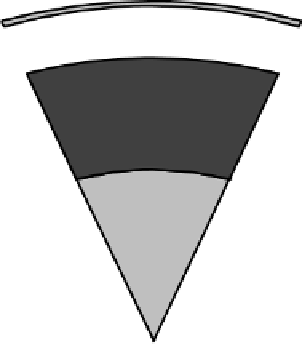Environmental Engineering Reference
In-Depth Information
thickness of around 10 km (Table 2.6). The Mohorovicic discontinuity separates
the earth's crust from the mantle. By going from the crust to the mantle, the veloc-
ity of seismic compression waves increases. The earth´s mantle is solid, and
reaches down to a depth of up to approximately 3,000 km. It surrounds the core of
the earth, which is assumed to be liquid, at least in its external part (approximately
3,000 to 5,100 km). The core shows no shear waves propagation (Fig. 2.54).
The upper crust of the earth up to a depth of approximately 20 km mainly con-
sists of granite types of rocks (approximately 70 % SiO
2
, approximately 15 %
Al
2
O
3
and approximately 8 % K
2
O/Na
2
O). The lower crust primarily consists of
basaltic rocks (approximately 50 % SiO
2
, approximately 18 % Al
2
O
3
, approxi-
mately 17 % FeO/Fe
2
O
3
/MgO, and approximately 11 % CaO). The mantle below
mainly consists of peridotite with the mineral olivine. It is assumed that the earth'
core consists of iron and nickel. The assumptions about the structure of the deep
earth are - among other studies - based on spectral analyses of extraterrestrial
bodies, composition of volcanic plutonic rocks and modelling of geophysical
measurements.
Crust
Crust
Upper mantle
Transition zone
Upper mantle
Transition zone
Mohorovici
c
discontinuity
Mohorovicic
discontinuity
0 km
0 km
400 km
400 km
1,000 km
1,000 km
Lower mantle
Lower mantle
Gutenberg
discontinuity
Gutenberg
discontinuity
2,900 km
2,900 km
Outer core
Outer core
Transition zone
Transition zone
4,980 km
4,980 km
5,120 km
5,120 km
Inner core
Inner core
6,370 km
6,370 km
Fig. 2.54
Basic structure of the earth (see /2-4/)
According to the theory of plate tectonics developed over the last decades, the
outer shell of the earth's crust consists of mainly solid plates (i.e. of the litho-
sphere) which are approximately 30 km thick, floating on a "softer" lower level
(i.e. the asthenosphere); see Fig. 2.55. This theory of plate tectonics is in line with
the layered structure of the earth discussed here. But in addition, it provides an
explanation for the dynamic processes such as the formation of new earth crust,
the subduction of plates or the volcanism at the boundary of lithosphere plates.
Temperature gradient.
The temperature gradient within the outer earth crust
which has been measured in deep wells, on average is 30 K/km (Fig. 2.56). In













Search WWH ::

Custom Search